With just two weeks left in the semester, it is time for my final media critique of the Detroit Free-Press. Coming into the beat, I was unsure how it would compare to my hometown St. Louis Post-Dispatch. And much like the Detroit Red Wings, I don't like the Free-Press very much. To start things off, the Free-Press's overall layout is bad. Very bad. It looks very plain and too constrained. There is a lot of white space on both sides of the website and there isn't very many lead stories on the home page. Also, there are a bunch of ads on the rights side of the site, which I think distracts from the stories trying to be presented. It would be in the site's best interest to get a design reboot. Now for the writing. Overall, I feel like the Free-Press has some good writing. A lot of the stories are written well and normal have a good amount of depth to them. I'm naturally drawn to sports stories and the Free-Press doesn't read like a box score too often. However, there isn't a lot of original reporting being done. Because the Free-Press is owned by the same company as USA Today, there are stories borrowed from USA Today and put on the site. If I were working for the Free-Press, I would want my stories to be published, not one from a reporter working for a different outlet than myself. One final aspect I disliked about the Free-Press was its archives. If someone were to look at a specific beat, whether it be the Red Wings, television, or community reporting, the archives would show stories from a month and a half ago. It would be much better for the Free-Press to not have them all on one page and instead show the last 10-15 articles per page. This would create a lot less clutter and still give readers the ability to find a story they were looking for. The Free-Press did add the feature pictured above during the time I was covering the beat. It's a slideshow of ten videos that changes every five seconds or so. When you click play, it loads the story right there and when you're finished, it automatically goes to the next video. It's a great way to showcase the videos on the site and makes it easier for viewers to find. I would like to see it moved up on the home page and possibly introduced to other channels on the site. The Detroit Free-Press would not be my go-to news site if I needed to find news. I would go to national news sources for big stories and sites such as ESPN for sports stories. If I were originally from Detroit, I may feel differently. But I'll take the Post-Dispatch any day.
When the news of the Boston Marathon broke, I was sitting outside my journalism class. I opened my computer to check Twitter and other news sites, trying to figure out what was going on. For the next hours, I was glued to my computer and the television, trying to figure out what was going on. So for this week's blog post, I wanted to see how the Detroit Free-Press covers the event a week later and how it compares to national news sites.
Immediately, the lead story on the Free-Press's homepage is a column about the Boston Marathon. Mitch Albom writes about the many instances he has experienced with danger and terror, from an East German translator who cannot enter a hotel strictly for foreigners, to having to sit away from windows in a Detroit neighborhood for fear of being shot. Albom discusses that the events of the marathon reminds us terror can strike us at any place, at any time, but we cannot be scared of it or let it define us. It's the same argument of people being scared of flying because of the crashes. Yes, occasionally planes do crash, but the odds of it happening are very small. The same can be said for bombings at sporting events.
This column reminded me of a column Marquette alumnus Steven Rushin wrote on the day the Boston Marathon bombings happened. He wrote of the last day of his daughter's summer vacation, when just he and her went to Boston for the day. He took her to her first Red Sox game and they were able to get a photo at the finish line of the Boston Marathon. That photo was sitting at Rushin's desk when he saw the footage of the bombings and when he was writing the column. It's a moving piece that has little to do with the actual events of the bombings, and is more of a reflective piece on what really matters in life.
Later Sunday night, I returned to the Free-Press's website, and the lead story was about Dzhokhar Tsarnaev being awake and responsive at a Boston hospital. The story went over the state of Tsarnaev at the hospital, and that officers were briefly investigating whether his neck injury was self-inflicted or not. Officials also said Tsarnaev was in no condition to talk thoroughly to police officers because his condition just recently stabilized.
One story I also found on the Free-Press website was a story about runners in the Lansing marathon. It was the story of two Chicagoans, Derek Bergey and Reyna Gonzalez. The couple saw what happened on Boston, and signed up for the soonest and nearest marathon. So on Sunday, they ran a half marathon wearing shits that said "For Boston" on the front and "The only thing we have to fear is fear itself" on the back. This was a common theme for runners, as many paid some form of homage, whether it was tapping the American flag at the beginning of the race, wearing blue and yellow clothes or even one man who wore a name tag with each fallen spectator on it. I found the response from the sporting world to be the best out of all venues in the past week.
On Bleacher Report, National Lead Writer Dan Levy talks about how the Boston Marathon wasn't about sports. The idea behind the bombing had nothing to do with the marathon, except for the venue. But, it was much more than that. Sports provides for an escape for people, leaving behind a world of politics and conflict. It's the hometown good guys versus the away bad guys. Sports provide an outlet for people to sit down and enjoy something perfect. The bombings violated the sanctity of sporting events.
If you need any proof that the city of Boston will not let the bombings define them, just watch the video of the national anthem at Bruins home game against the Buffalo Sabres. Look at David Ortiz's pre-game speech before the Red Sox faced the Kansas City Royals. But it was also a national event. The crowd at Scottrade Center in St. Louis erupted at the news of suspect 2's arrest in a game between the Blues and Dallas Stars. In a post-9/11 world, the United States is desensitized to these kinds of acts of violence. But the works of Albom, Rushin and Levy show that the Boston Marathon is an important history marker in the U.S.'s life. There's an old saying that journalism is the first draft of history, and the columns above show journalism isn't dead. Instead, they show journalism is more important than ever.
The event of Monday's bombings will not soon be forgotten. What happened at the Boston Marathon will be burnt into the memories of everyone around the nation, especially those with families and friends competing. However, what happens when the news breaks five minutes before a journalism class? The logical choice would be to scrap the lesson plan and to learn from the experience. Cover the breaking news and learn on the fly, much like the reporters on air are doing. But that's not what happened. Instead, in #loweclass we worked on our Milwaukee Neighborhood News Service projects. I am not blaming #loweclass for working on those projects. They need to get done and be edited in order to be published, which is the overall goal for the assignment. But they were submitted on March 8, the Wednesday before spring break. Today is April 15, more than a month after the due date. If it was such a necessity to have these projects edited in order to be published, why wasn't there more urgency to get these edits done and back to the students so they can do the necessary revisions? What I am saying is that despite the fact there are stories that needed attending to, a breaking news event such as this needs to be given the utmost importance. This blog post would not be written if today were any regular day. Nine times out of 10 I would have welcomed working on these projects to get them published. But today was not an ordinary day. News outlets such as Fox News and CNN probably had stories they thought were going to be great and were going to be the lead stories on each respective website. But they trashed those ideas and immediately went to covering the bombings. They had no contingency plan for if a bomb exploded at the Boston Marathon. But they had to cover the story, flying by the seat of their pants, finding out the news and reporting it at the same time to the public. Why wouldn't the class learn how to do the same thing? We even had one of CNN's senior editors, Mira Lowe, in class last Wednesday. She discussed the " This Just In" blog on CNN, the center for breaking news for the site. Why wouldn't class take a look at this blog when we had just met the person managing the blog? Not only does the class know how the information is being presented, but it knows the person in the newsroom sorting through and publishing that same information. How many journalism students can say that? #Loweclass is a Journalism III class, an upper level class that focuses on creating stories. So why isn't that class doing journalism when the chance for journalism emerges? We, as students, should have been paying attention to how each news site covers this story. We should have been critiquing what they were doing and discussing how we would have covered the event. But most importantly, we should have been paying attention to how its being covered because it is going to happen again. As much as I hate to say it, there is going to be another tragedy, and we, the future journalists of the world, need to know how to cover a tragedy such as this and have the experience to do so. The College of Communication preaches that communication and journalism students shouldn't be doing the classes for the grade but for the career. So why were we focused on doing something for the grade, not the career? Maybe it's because I had a friend that was running in the marathon and I was upset he had to be put through something like this. Perhaps it's because the journalist in me wanted to be a part of something that was going to make difference. Or maybe it's just because I hate being out of the loop of information. But overall, I am severely disappointed my journalism class didn't do journalism.
For Wednesday's class, #loweclass was lucky to have CNN Digital Media Editor Mira Lowe visit. Lowe was in Milwaukee to be the keynote speaker for the Midwest Regional Summit for the National Association of Black Journalists. Even though she was telling the students about what her work was and how she did it, she told students she wanted it to be more of a conversation rather than a lecture. Lowe started off my explaining how CNN creates its homepage. She discussed how the homepage is like the door to the house. It brings in the readers and shows them where everything else is. Lowe discussed which stories were the leads and which were in the center and why each story was there. On the homepage that day, the lead story was a piece on North Korea, which Lowe explained to be there because of its national relevance. Lower down on the page there was a story about traveling to Myanmar, which was there because it was a lighter piece that people would click on later in the day. Next, Lowe discussed the five pages she manages ( Entertainment, Technology, Health, Travel and Living). She went to each page and briefly discussed our media critiques from Monday, stating each feedback was good and had valid points. It was great to hear that something I wrote was read and approved by an editor of CNN. Lowe also talked about what her actual job was like. Every day she has meetings at 8 a.m., 9 a.m. and then around 2 p.m. Each meeting has a different purpose. For example, her 8 a.m. meeting is between her respective desks, while the 9 a.m. meeting is with her boss. her 2 p.m. meeting is with her desks to see how their progress was during the day. Being the manager of five different channels, Lowe is in charge of making sure each channel has stories coming out throughout the day. She said because things can be uploaded immediately, writers have deadlines based on stories, not a specific time. This allows for stories to be submitted throughout the day and not bombard readers with a lot of stories all at once. Towards the end of the class, Lowe showed a CNN she was very proud of. The story was " The gift of Charles," a piece that had video, text and photos. This story was the story that sold her on accepting the job at CNN. Lowe said the story sold her because it was a different style of news than what she had seen in other publications, and it was where the online media was heading. Even though it was a long video, Lowe said if a story is compelling, then people will watch it, no matter how long it is. That really stuck out with me because I normally have to leave a lot of good audio or video on the cutting floor, and I feel like the viewers are losing out with those pieces not in the story. I would love to include them in the story, but time restraints limit me. But if it's a great story, then people will read it, which is the whole point of a story in the first place. The advice that Lowe gave the class that was the most important was advice on internships, in my opinion. Being a CNN editor, she receives a multitude of applications for internships. She said that the ones that stand out the most are ones where she can see the person's passion in their cover letter and application. Lowe said that passions is extremely important because she wants someone who wants to be at their job and one who is going to have a good time doing it. If you're not passionate about what you do, then why are you in the field of journalism? This was another thing that stood out in my mind because I am sending out applications for internships and I know I have a passion for what I am doing. it's just about getting the chance to show my employers that passion. Having Mira Lowe visit class was a great experience. Marquette University does a great job of bringing accomplished speakers to campus, and Lowe is no exception. I thoroughly enjoyed the experience and would welcome a return from her.
On Wednesday, #loweclass will welcome CNN Digital editor Mira Lowe to class. In preparation, students are examining five channels of CNN and comparing them to our own beat sites, mine being the Detroit Free-Press. In order to decide which site covered each channel better, I will be awarding points. The better site gets a single point. The site with the most points wins. The first page I compared was the entertainment page. For CNN, the page was visually stunning. There are pictures for nearly every lead article. There were categories for music, TV and even casting news. Meanwhile on the Free-Press's entertainment page, the lead story was on Art X, a art festival coming to Midtown. This story was the only lead story with a photo. But while CNN had the better page visually, the Free-Press had more coverage of entertainment. Stories ranging from a piece on Kurt Cobain's suicide anniversary to Evil Dead making $26 million on the weekend. In a head to head battle, I'd give each site a half point; CNN for its visuals and Free-Press for wide range of coverage. CNN: .5 Free-Press: .5The next head-to-head battle is the technology page. CNN's site opens with a story on how to control a computer with a banana. But it's not just limited to a banana, but anything that can complete a circuit, which, as the video shows, is even Play-Doh. How awesome is that?! CNN's coverage also dives into the business side of technology, which is an aspect I did not expect to find. The Detroit Free-Press's technology page was not on the homepage, but under the life drop-down menu. There were no lead stories on the technology page. Instead, it was the top technology news, which had stories dating back to March 18, 2013. Three of the first four stories were about Facebook. To me, it seemed like a lot of the Free-Press's coverage was fluff, while CNN's was extensive. CNN clearly won this matchup. CNN: 1.5 Free-Press: .5Health news is next, and again CNN looks great. The story that caught my eye was one about a man with autism. The story is about a kid who was diagnosed with autism at age 5, and how he overcame obstacles in life and now attends college and also has written a book. The best part? He also wrote the story. Because I worked with autistic kids for the past two summers, this story was an awesome read. The rest of the health homepage was extremely colorful, with lots of photos. There were even videos that viewers could watch. The health page was also on the Free-Press's life drop down menu. Again, the Free-Press has top health news. These stories were wide-ranging, much like its coverage of entertainment. These stories were well written and had a lot of substance to them, but overall, there weren't any stores that stuck out in my mind. CNN's coverage was extensive and visually compelling, while the Free-Press was hit and miss. I have to give it to CNN again. CNN: 2.5 Free-Press: .5The living page of CNN was laid out exactly like the health page, which was good to see. Again, CNN immediately had a story that caught my eye. This was about a school in Wilcox County, Ga., that was going to have its first integrated prom. Yes, that's correct. A school that has been desegregated since the '60s still was having all-white dances and all-black dances. But in 2013, they were going to have an integrated prom. Call me sheltered, but I had no idea stories such as this one still existed, so major props to CNN for covering this dance. The closest thing the Free-Press had to a living section was its life section, which encompassed areas such as food and shopping, as well as the channels of health and technology, which was already covered. Unlike CNN, the Free-Press did not have any story that caught my eye. One story that was part of the travel/food section was how to tell if horse meat is on a foreign menu. Given the scandal of a British retailer having horse meat in some of its burgers, this story would be something of interest for a traveler. CNN again wins this battle because of better coverage and a better page overall. CNN: 3.5 Free-Press: .5The final matchup pits the travel pages together. CNN again has the same layout for travel as it does for health and living. I would have liked to see something different on this homepage, but that's all I can complain about. The lead story is about how Washington's legalization of marijuana has increased the economy. Another great story was about the seven most fun airports around the world, which included the Munich Airport and its beer garden and San Francisco's many museums. The Free-Press's travel page is more of the same. It only features the top travel news stories, and there really isn't any story that draws in my attention. The one that's closest is a story on the TSA chief saying he'd let travelers bring small knives on planes. Frankly, I don't understand why people could bring knives on a plane, but a regular tube of toothpaste or contact solution is completely out of the question. CNN again wins this battle of the channels. CNN: 4.5 Free-Press: .5Well, there's your final score folks. CNN nearly completed the sweep, but the entertainment page of the Free-Press was the saving grace. CNN shows why it is the Goliath of news coverage, and why the Free-Press is David. If this were a hockey game, CNN would be the Chicago Blackhawks and the Free-Press would be the Florida Panthers. It was no contest.
Being at Marquette University, there are certain perks that come along with attending a Catholic university. Despite the standard break fro Christmas, we also get a break for Spring Break and Easter. The break provides a great small absence towards the end of the semester, much like fall break in the first semester. For the Detroit Free-Press though, religion is just an after thought. On Saturday night, I went to the Free-Press's website to see if there was any preparation for Easter. I was met with coverage of the day's Final Four games, as well as general news from around the Detroit area. I quickly looked around to see if I could find any thing about Easter or Passover or any other religious holiday, but could find nothing. On Easter I returned to see if there was anything else, and the only thing I could find were slideshows. The first was a slideshow of Easter foods, which were homemade from Linda Willette, who made linguini, Sicilian sweet bread and canolies. The photos were well taken, but they were of one family's tradition for Easter. It would have been great to see what other families were doing for Easter. Another slideshow was from a Easter Vigil at Cobo Center. This photo gallery featured many candid shots, especially the one of the baby sleeping. I believe it is a great way for someone who is not knowledgeable in the Christian faith to see what goes on in a Mass as high profile as Easter Sunday. However, these were the only stories on Easter. For the Free-Press, I feel like there should be a religion beat. It is extremely difficult to find a religion-based story on the Free-Press's website because there is no religion sub-header. There was no mention of Passover, no mention of any other religious practices. It would have been great to see these other religious practices, especially in something more than a photo gallery. In a time where political correctness is at an all-time high, it's understandable for the Free-Press to have little coverage of religion on its website. But if one religion is being covered, it would have been great to see others covered. I would like to see the Free-Press to take a more active role in covering religion in the Detroit area.
Thursday and Friday marked arguably the two most exciting days of all of sports. Sixteen games a day, spanning 12 hours, captivates the country with fans breathing sighs of relief when a team advances or lighting their paper brackets on fire when their national champion bows out in the first round. The Detroit Free-Press focused on both Michigan and Michigan State, two teams who could potentially win the national championship. Michigan opened the tournament against South Dakota State and was a fairly popular upset pick. The Wolverines took care of business, winning 71-56, but did so in an unusual way. Instead of relying on Naismith Award finalist Trey Burke, freshman Tim Hardaway, Jr., led the team with a career high 21 points. In the round of 32, Michigan obliterated VCU 78-53, reaching the Sweet Sixteen for the first time since 1994. The victory was so convincing, Dick Vitale said the Wolverines were playing like the number one team in the nation again.
The higher ranked Michigan State also managed to make it to the Sweet Sixteen. The Spartans first took on Valparaiso in the first tournament game overall, winning 65-54. In the second game of the tournament for the Spartans, Michigan State defeated Memphis handedly, 70-48. The win gave coach Tom Izzo his 11th Sweet Sixteen appearance in 16 tournaments.
As for the Free-Press's coverage, it was extremely well done. For each game, there was a live blog, where fans could follow along live with the Free-Press. In addition, fans could ask questions or give their own comments that others could see in the live stream. This led to interaction between other fans and the beat writer for each team. Also, each post game story had video of the Free-Press breaking down the game and giving important analysis.
Overall, I feel like the Free-Press did a great job with covering two teams in the national tournament. Each team got analysis before and after each game. Each game had a live blog for fans to follow along. Both print and video is being used in the stories. While the Free-Press may not be the go-to site for March Madness coverage, if I were a fan of either team, this would be my first stop.
With the second half of the semester beginning, #loweclass will start to incorporate video into our stories. Therefore, we were asked to critique our beat's use of video. The Detroit Free-Press uses video in the same way that we are taught to use photos, to tell a story that advances the story being told on paper. The Free-Press uses video in different ways. In sports stories, the main style of video used is post-game press conferences. Readers get to see video of players and coaches answering questions. This allows for the reader to see the non-verbals of the quotes that appear in the text stories. However, it would be better if the Free-Press would use game highlights in their videos. Some readers may not have been able to see the game, so highlights would be a great way to keep viewers on the page. As for news, the Free-Press offers its videos a little differently. The majority of stories are just accompanied by photos and allow for the text to tell the story. Then, there are stories that are told strictly through video with no text. I find these to be both refreshing while also inconvenient. For instance, I watched a video about beavers being found in the Detroit River. Was it really necessary to have a three and a half minute story based solely on an animal? The text story would have been extremely short, yet video allows the story to have some depth. So the story was told through the best medium possible, but was it worth being a story? One area the Free-Press lacked video that surprised me was in entertainment. Before touring the website, I figured entertainment would have the most video. But the Free-Press did not have a single video piece in the headlines on the home page and had a couple in the carousel on he entertainment homepage. However, the video was used to add to the stories. For example, in the story about rapper Tone Loc collapsing on stage, the video is raw footage of paramedics checking out the rapper. I feel like this was great use of video to advance a story, yet it may have been more useful as a hyperlink rather than the dominant feature of the story. Overall, the Free-Press uses video to its advantage more than as a disadvantage. The homepage has a multimedia section devoted to each desk of the newspaper and normally accompanies a story in some way, shape or form. There are some areas where video can be improved on, but otherwise, the Free-Press succeeds in using video to advance stories.
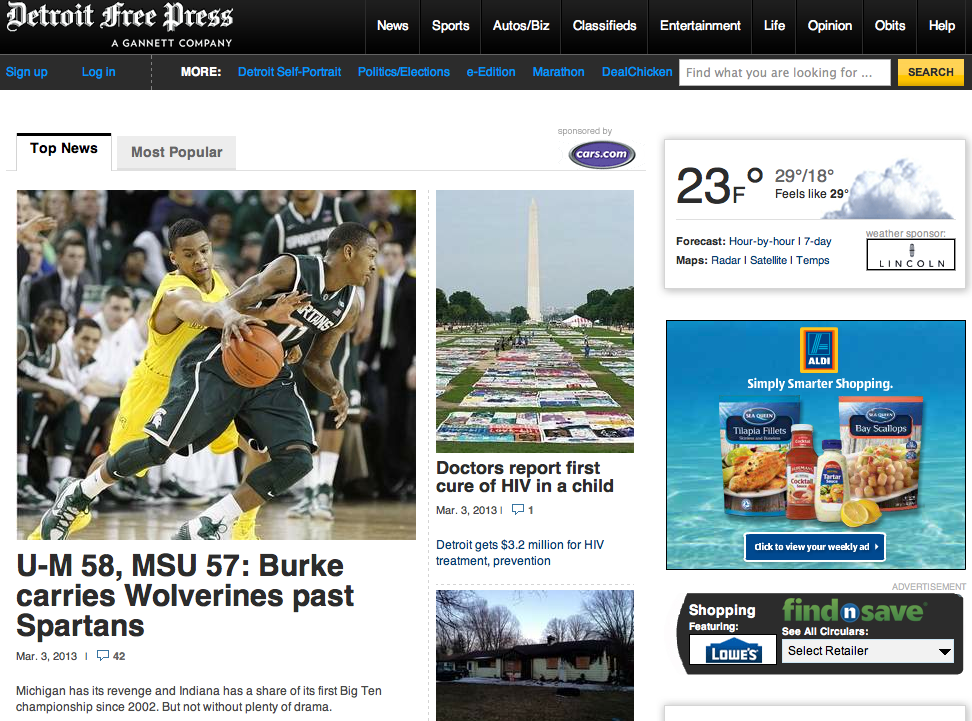 The homepage of the Detroit Free-Press, whose dominating story is game coverage of the Michigan-Michigan basketball game. Normally when I'm can choose my own topic for my #loweclass weekly blog post, I cover something sports related. However, this weekend I was going to try to cover something different for my beat, to not only give myself a change of pace, but my readers as well. But after the drama of the Michigan-Michigan State basketball game, I had to critique the Detroit Free-Press's coverage of the game. As I was reading the article, I was happy with what the Free-Press had done to cover the game. The Free-Press had their own reporter cover the game rather than someone working for USA Today, and there were three videos of post-game press conferences, which I think more news outlets should do. Give readers the ability to not only read the reporters analysis of the game, but also what the respective coaches thought about the game. The lead in the story was also the caption for the photo on the homepage, which I think is a little lazy by the reporter and the designers of the website. But, it still serves the purpose for drawing the readers to click on the story. Another aspect of the story that I enjoyed was "the breakdown." The breakdown highlights the hero of the game ( Trey Burke), the goat ( Keith Appling) and an interesting fact of the game, which in this case, happen to be the alumni of Michigan State purchasing fifty tickets so Michigan State students could attend the basketball game. I applaud the Michigan State alumni for doing so, because having fans being able to cheer on their team in an opponent's arena can give the team a little extra edge. Just ask Marquette. My only complaint is the story is a little short and lacks depth from outside the last four minutes of the game. Sure, the run by Michigan State in the last four minutes created the drama, but there had to have been bigger events that happened outside of the time frame. Was there a big dunk that caused the student section to erupt? A block that stopped Michigan State cold for a few minutes. A player that saw a unusual amount of minutes? The readers don't have the answers to these questions because these moments are never talked about. The piece by the Free-Press is good though. It highlights the biggest point in the game and looked ahead for both teams. I would have liked too seen a little more analysis of the game overall, but the story wasn't necessarily an analysis of the game as much as coverage of the game. The author of the article was a member of the Free-Press and put effort into the multimedia to tell the story even more.
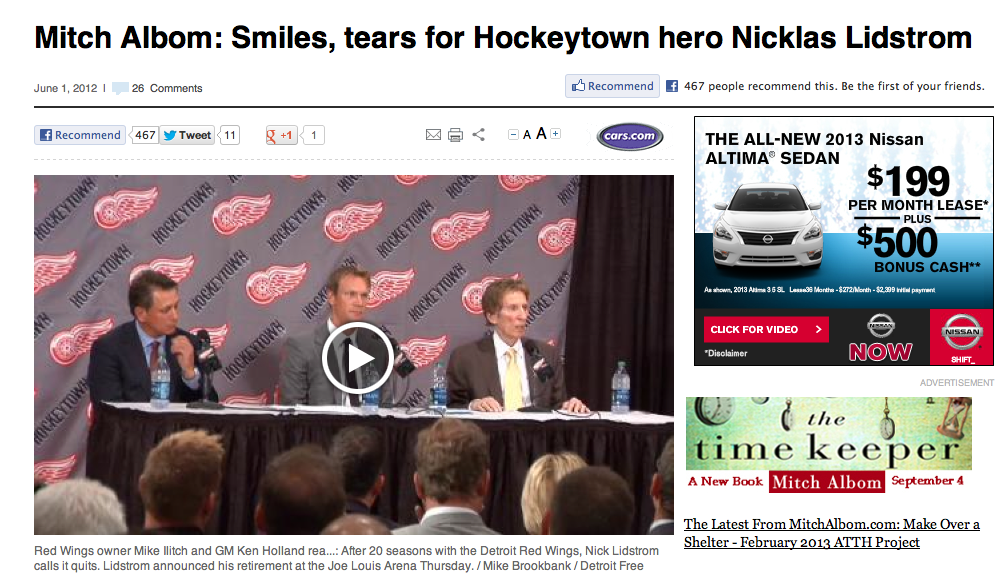 Nicklas Lidstrom retired on June 1, 2012, after playing 20 seasons for the Detroit Red Wings All across the United States and Canada, Feb. 17 was Hockey Day in America. NBC had nationally televised games all day and 14 of the league's 30 teams were playing. With no real profiles on the Detroit Free Press' website, I decided to go back to June 1, 2012, when one of the Red Wings' greatest players decided to retire. Nicklas Lidstrom's retirement was not the least bit shocking, but fans still did not want to see their captain retire after 20 seasons. Lidstrom was the definition of a leader and was a class act on and off the ice. The article touches on these facts, but they are well known in the hockey community. So, the article decides to look at how the way he retired reflected these attributes. The article even has a looking forward piece, a critical part of profiles as Marco Williams pointed out to #loweclass last week. The going forward aspect of the story was what Lidstrom was going to do after retirement. Rather than become a media personal to NBC or the Wings' Fox Sports affiliate, Lidstrom decided to return to his hometown in Krylbo, Sweden. The profile does a great job in letting a little known fact about his hometown having the largest wooden horse in the world before he left and it still being there today. One aspect of the profile I did not like was the authors weird fascination by adding -eth to the end of some words, as if it adds some sort of storybook flow to the article. I get the idea of trying to implore a "the Lord giveth, the Lord taketh away," feeling towards the article to show how lucky fans have been. But having it in the lede and one of the last sentences of the article was not a smart move by the writer. The article may be slightly untimely, but I believe this article is a great example of what a profile should be. It captures the personality of Lidstrom in details and quotes, while still giving readers a reason to continue. On Hockey Day in America, there is no better person to do a profile on than Nicklas Lidstrom.
|
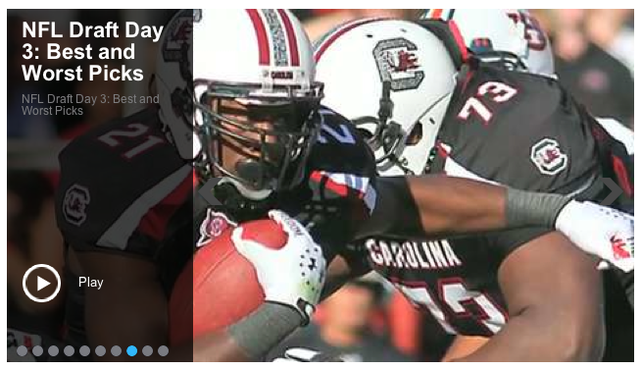
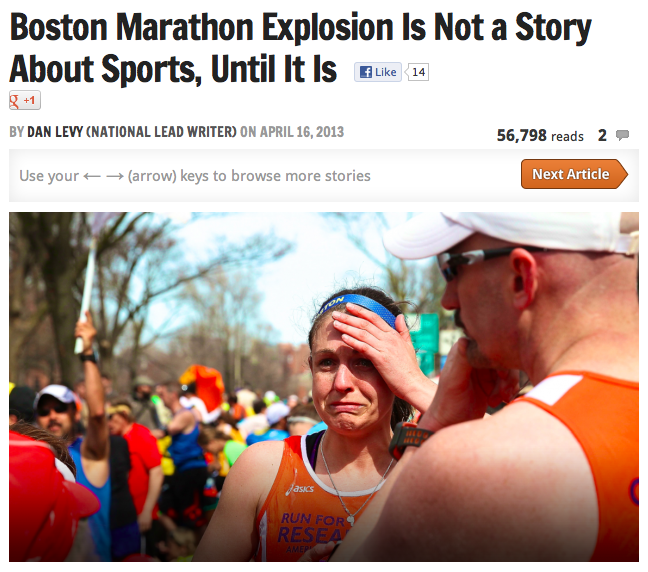
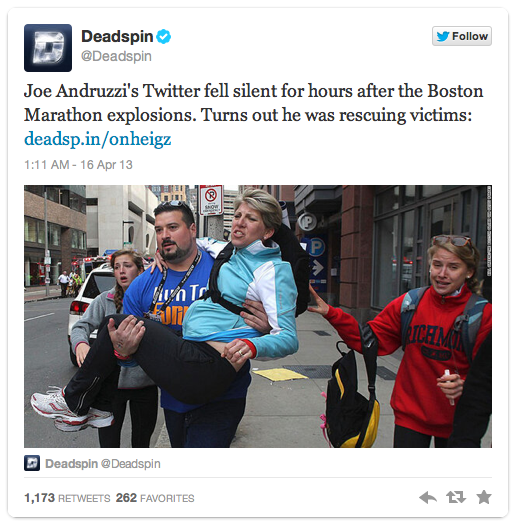
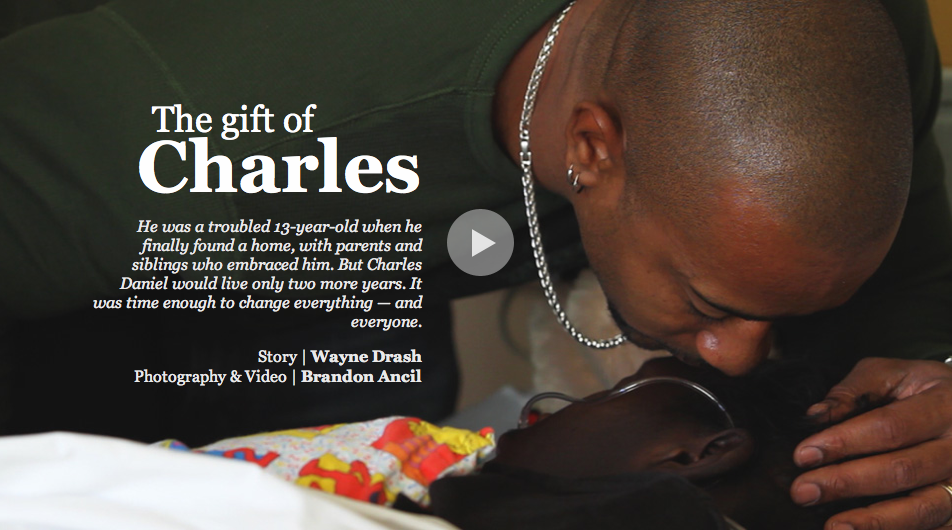
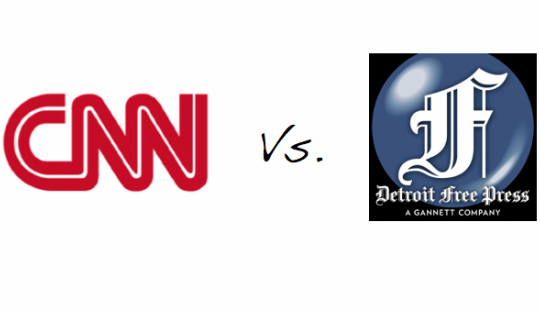
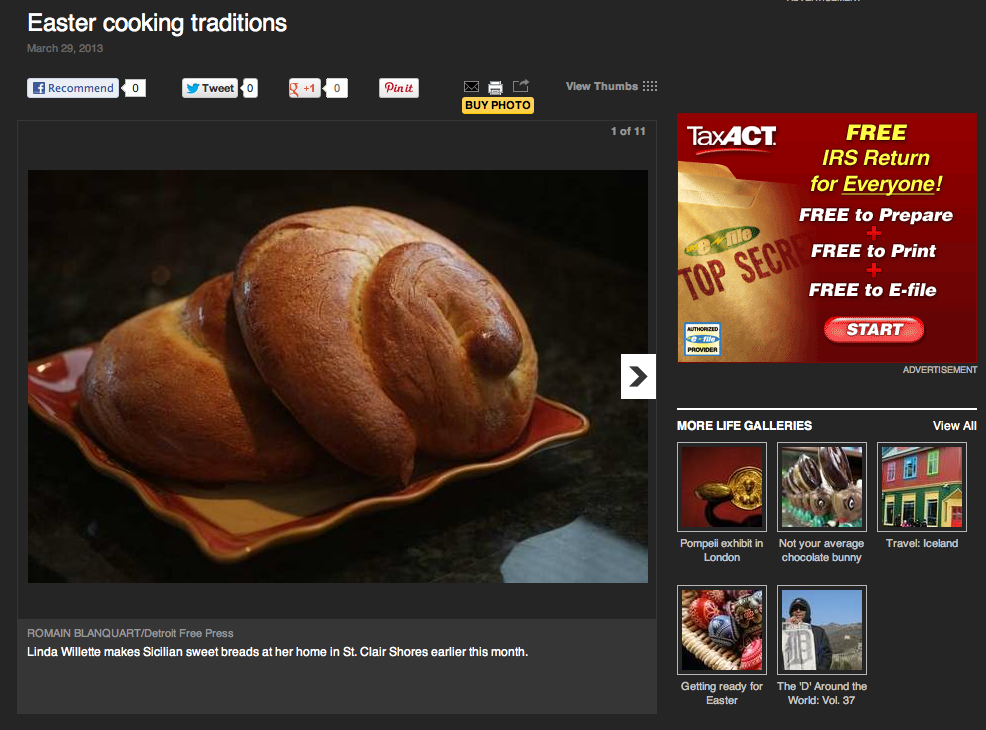

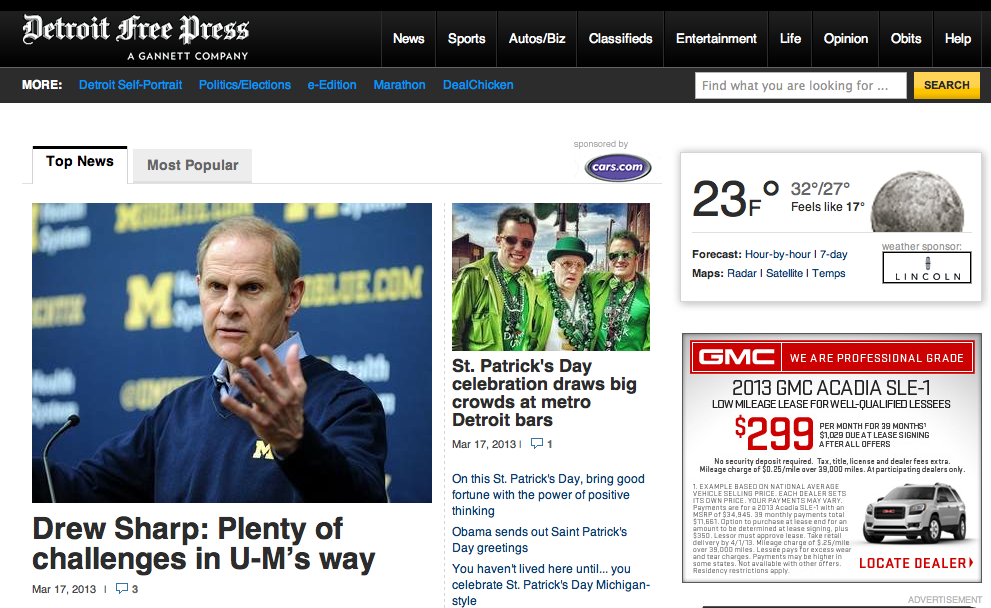



 RSS Feed
RSS Feed